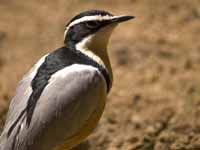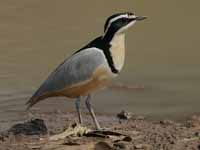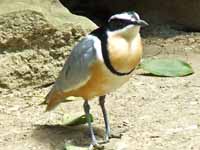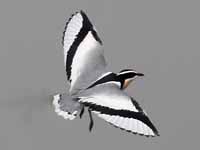THE WORLD BIRDS - An Online Bird Book
SHOREBIRDS
Coursers and Pratincoles
Order Charadriiformes Family Glareolidae
SHOREBIRDS
Most Shorebirds walk along shores probing for food with their thin sensitive bills. Bill length varies considerably so differing species can work the same shore and obtain different
food supplies. Shorebirds include sandpipers, godwits, stilts, oystercatchers, plovers, and many more. Shorebirds belong to the Charadriiformes order which also includes the Gulls
and Allies.
Note: the term Shorebirds is used in the Americas; elsewhere "waders" is used. We will reserve "waders" for herons and allies.
Some Charadriiformes families:
Burhinidae: thick-knees; Charadriidae: small plovers, lapwings; Glareolidae: courses, pratincoles; Haematopodidae: oystercatchers
Jacanidae: jacanas; Recurvirostridae: avocets, stilts; Scolopacidae: small bill sandpipers, large bill sandpipers.
Note: the term Shorebirds is used in the Americas; elsewhere "waders" is used. We will reserve "waders" for herons and allies.
Some Charadriiformes families:
Burhinidae: thick-knees; Charadriidae: small plovers, lapwings; Glareolidae: courses, pratincoles; Haematopodidae: oystercatchers
Jacanidae: jacanas; Recurvirostridae: avocets, stilts; Scolopacidae: small bill sandpipers, large bill sandpipers.
Coursers and Pratincoles
Order Charadriiformes Family Glareolidae
The feature that defines the Glareolidae family from the rest of the order is the bill, which is arched and has the nostrils at the base. They have an Old World distribution, occurring in southern Europe, Asia, Africa, and Australia. Insects form the majority of their diet.
Coursers have long legs, which are used to run (giving the group its name). They feed in a plover-like fashion, running, then stopping to scan for prey before moving on. The wings are shorter and have a more sustained flight than that of the pratincoles. The coursers are typically found in open and arid environments such as deserts and scrub. The coursers are not particularly migratory.
Pratincoles have short legs, long pointed wings and long forked tails. They have a buoyant flight that allows them the unusual (for the order) hunting technique of taking their insect prey on the wing. They are able to capture their prey on the ground as well. They live near wetlands, rivers, estuaries and other inland waterways. The wings also allow for long migrations in some species.
Genus Cursorius
These coursers breed in warmer parts of Africa and South Asia. They have long legs, short wings and long pointed bills which curve downwards. Although classed as waders, they inhabit deserts and similar arid regions. They hunt insects by sight, pursuing them on foot.
Courser,_Burchell's Cursorius rufus Found: Africa
The Burchell's Courser has dark brown upperparts, upper-breast; rufous fore-crown; gray hind-crown; rufous lower-breast, upper-belly; black between upper- and lower-belly; white lower-belly, legs.
Similar to: Temminck's Courser. Burchell's Courser has gray hind-crown; Temminck's Courser has rufous crown.
Image by: 1) Chantelle_Bosch - Namibia 2) Jerry Oldenettel - Namibia 3) Johann du Preez Similar to: Temminck's Courser. Burchell's Courser has gray hind-crown; Temminck's Courser has rufous crown.
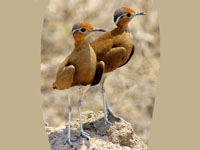

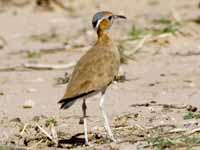
Courser,_Cream-colored Cursorius cursor Found: Canary Islands, north Africa, southwest Asia
The Cream-coloured Courser has sandy colored upperparts; whitish belly; gray crown and nape; black eye-stripe; white supercilium; long legs; long wings; slightly downcurved bill. They prefer open ground, preferably semi-desert.
Similar to: Somali Courser. Cream-colored Courser is lighter / sandier than Somali Courser.
Image by: 1) Didier_Descouens 2) Frank_Vassen - Canary Islands 3) Dave Curtis 4) Shah Jahan - Dibba, United Arab Emirates 5) Brendan Ryan 6) Dibyendu_Ash Similar to: Somali Courser. Cream-colored Courser is lighter / sandier than Somali Courser.
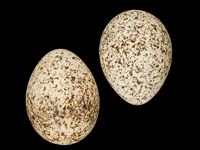
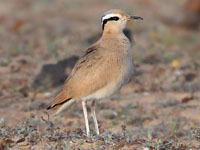
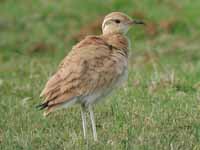
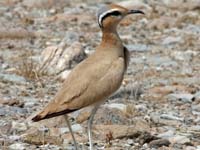
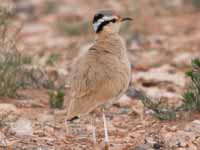
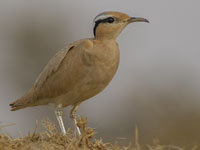
Courser,_Indian Cursorius coromandelicus Found: South Asia
The Indian Courser has a chestnut crown; wide black eye-line; white supercilium; rufous breast; whitish long legs.
Image by: 1, 2) Koshy_Koshy 3) Santanu_Nandy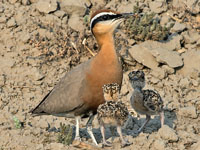
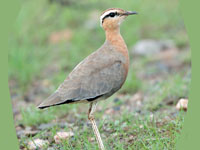
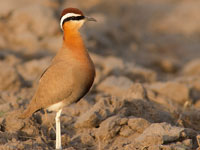
Courser,_Somali Cursorius somalensis Found: Africa
The Somali Courser is also considered to be a subspecies of the Cream-coloured Courser. They prefer open ground, preferably semi-desert.
Similar to: Cream-colored Courser. Cream-colored Courser is lighter / sandier than Somali Courser.
Image by: 1, 2, 3) Nick Borrow Kenya, Kenya, Ethiopia 4, 5) Steve Garvie - Kenya Similar to: Cream-colored Courser. Cream-colored Courser is lighter / sandier than Somali Courser.
1) Juvenile
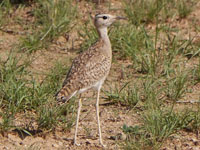
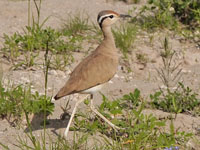

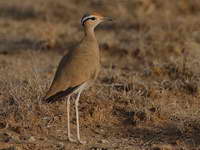
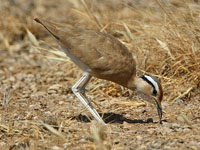
Courser,_Temminck's Cursorius temminckii Found: Africa
The Temminck's Courser has dark brown upperparts, upper-breast; rufous cap, lower-breast, upper-belly; black between upper- and lower-belly; white lower-belly, legs.
Similar to: Burchell's Courser. Burchell's Courser has gray hind-crown; Temminck's Courser has rufous crown.
Image by: 1) Steve Garvie - Kenya 2) Nik_Borrow - Namibia 3) Marcel
Burkhard 4) ChandresSimilar to: Burchell's Courser. Burchell's Courser has gray hind-crown; Temminck's Courser has rufous crown.
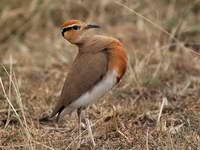
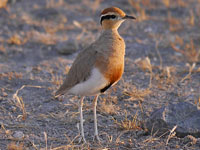
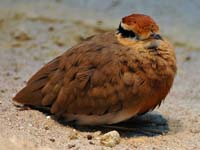
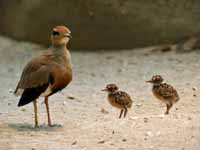
Genus Glareola
See also genus Stiltia for another pratincole.
Pratincole,_Black-winged Glareola nordmanni Found: southeast Europe, southwest Asia
The Black-winged Pratincole has brown back and head; brown wings with black flight feathers, black under-wings; light buff throat with black border; white belly; short legs.
Similar to: Collared Pratincole. The Collared Pratincole has a longer tail than the Black-winged Pratincole.
Image by: 1) Marcel Holyoak - Israel 2) Ian_White 3, 4) Dave CurtisSimilar to: Collared Pratincole. The Collared Pratincole has a longer tail than the Black-winged Pratincole.


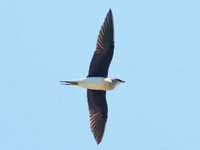
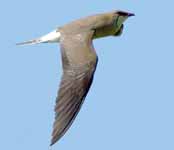
Pratincole,_Collared Glareola pratincola Found: Europe, Asia, Africa
The Collared Pratincole has brown back and head; brown wings with black flight feathers, chestnut underwings; light buff throat with black border; white belly; long forked tail.
Similar to: Black-winged Pratincole. The Collared Pratincole has a longer tail than the Black-winged Pratincole.
Similar to: Oriental Pratincole. The Collared Pratincole has a longer tail than the Oriental Pratincole.
Image by: 1) Steve Garvie - Kenya 2) Nik_Borrow - Uganda 3) Werne Witte - Africa 3) Steve_Garvie 4) Sergey YeliseevSimilar to: Black-winged Pratincole. The Collared Pratincole has a longer tail than the Black-winged Pratincole.
Similar to: Oriental Pratincole. The Collared Pratincole has a longer tail than the Oriental Pratincole.

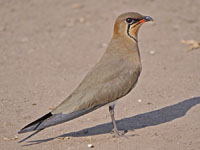
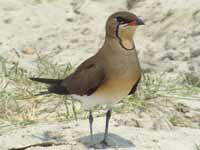
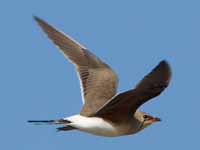
Pratincole,_Gray Glareola cinerea Found: Africa
The Gray Pratincole has gray upperparts; white supercilium, throat, underparts.
Image by: 1) Seth of Rabi 2) Frans_Vandewalle - Chad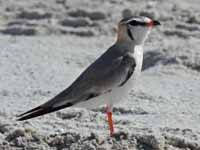
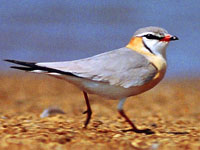
Pratincole,_Madagascar Glareola ocularis Found: Madagascar
Image by: 1) Heinonlein 2) David Cook 3) Jerry_Oldenettel
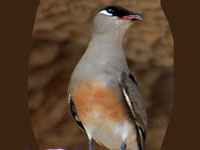

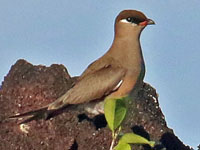
Pratincole,_Oriental Glareola maldivarum Found: Europe, Asia, Australia, New Zealand
The Oriental Pratincole has brown back and head; brown wings with black flight feathers, chestnut underwings; light buff throat with black border; white belly; short red bill; black legs.
Similar to: Collared Pratincole. The Collared Pratincole has a longer tail than the Oriental Pratincole.
Image by: 1,4) Charles Lam 2) JJ_Harrison - Thailand 3) David_Cook 5) Andy_Li Similar to: Collared Pratincole. The Collared Pratincole has a longer tail than the Oriental Pratincole.
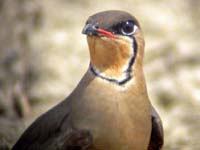
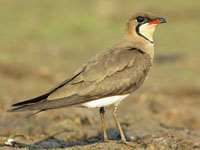

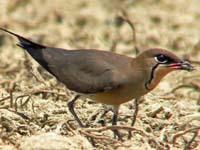
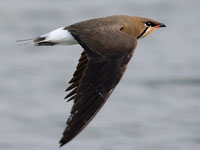
Pratincole,_Rock Glareola nuchalis Found: Africa (near exposed rocks in moving water)
The Rock Pratincole has brownish-gray upperparts, breast; upper-belly; white lower-belly; black crown; red base of bill.
Image by: 1, 2, 3) Nik_Borrow - Zambia, Sierra Leone, Sierra Leone 4) Francesco_Veronesi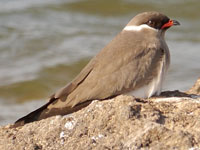
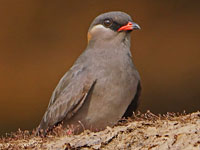
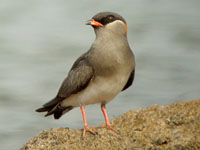
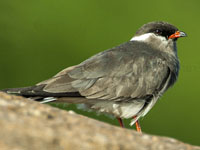
Pratincole,_Small Glareola lactea Found: India, western Pakistan, southeast Asia
The Small Pratincole has gray upperparts; brown head; light gray upper-breast; white lower-breast, belly, gray upper-wings with black primaries and white bars at rear edge of inner flight feathers; mainly black under-wings; white tail with black terminal triangle.
Image by: 1) vaidyarupal 2) Sergey Yeliseev 3) Sai_Adikarla 4) Sp herp 5) JM Garg 6) Aditya Joshi 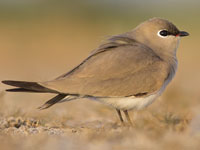
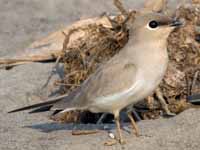
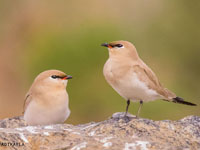
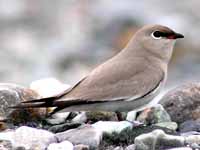
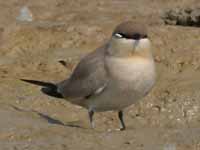
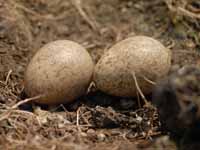
Genus Rhinoptilus
These coursers breed in warmer parts of Africa and South Asia. They have long legs, short wings and long pointed bills which curve downwards. Although classed as waders, they inhabit deserts and similar arid regions. They hunt insects by sight, pursuing them on foot.
Courser,_Bronze-winged also Violet-tipped Courser Rhinoptilus chalcopterus Found: Africa
Image by: 1) Bernard_Dupont - South Africa 2, 3) Derek_Keats - South Africa
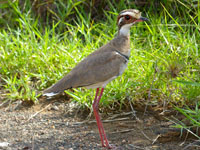
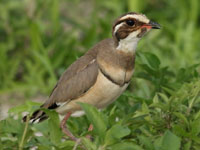
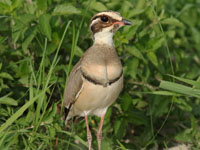
Courser,_Jerdon's Rhinoptilus bitorquatus Found: India
The Jerdon's Courser has two brown breast bands; blackish crown; whitish supercilium; white throat, belly.
Image by:
1) Biodiversity Library 2) PJeganathan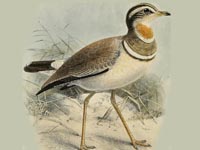
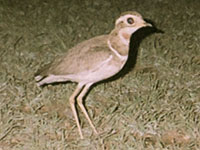
Courser,_Three-banded Rhinoptilus cinctus Found: Africa
Image by: 1) Francesco Veronesi 2, 3) Johann du Preez 4, 5) Nik_Borrow - Ethiopia, Kenya
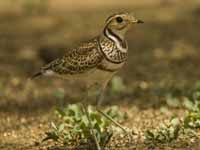
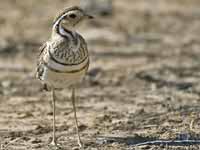

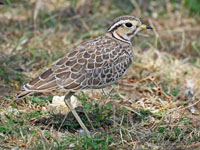
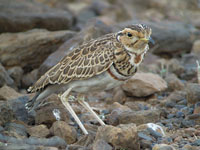
Courser,_Two-banded also Double-banded Courser Rhinoptilus africanus Found: Africa
The Two-banded Courser has sandy brown back with white mottling; two narrow black breast-bands; narrow black eye-line from bill to nape; buff underparts becoming lighter on belly; black bill; pale gray legs.
Image by: 1) Derek_Keats - South Africa 2) Dick - Tanzania 3) Nik_Borrow - Tanzania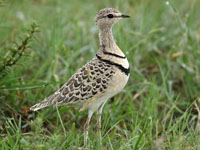
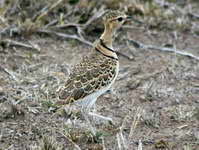
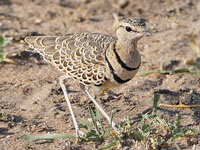
Genus Stiltia - 1 species
See also genus Glareola for more pratincoles.
Pratincole,_Australian Stiltia isabella Found: Australia
The breeding Australian Pratincole has sandy brown upperparts, head, neck, breast; white chin; dark brown iris; black belly; red bill with black tip; white lower eye cresent. Nonbreeding plumage is grayer.
Image by: 1) Jim Glas - Adelaide Zoo 2) Brian_McCauley 3, 4) Geoff Whalan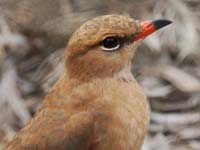
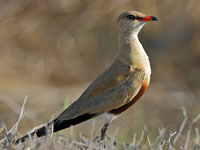
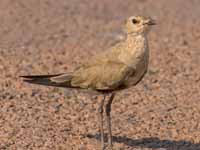

Family Dromadidae - 1 genus
The Crab Plover may be closely related to the pratincoles, but this is debatable.
Genus Dromas- 1 species
Plover,_Crab Dromas ardeola Found: Coasts of Indian Ocean
The Crab Plover has white plumage except for black back and primary feathers of the wings. It has a massive black bill for eating crabs.
Image by: 1, 2) Tarique Sani 3, 4) LonelyShrimp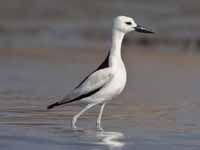
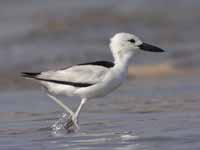
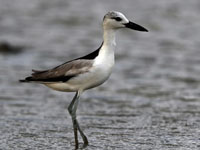
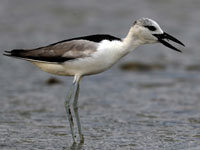
Family Pluvianellidae - 1 genus
Genus Pluvianellus - 1 species
Plover,_Magellanic Pluvianellus socialis Found: southern-most South America
The Magellanic Plover has gray upperparts; white underparts. It stomps on mud to liquify it and force out prey. Closet relatives may be sheathbills.
Image by: 1) Nick Athanas - Chile
2) Gunnar_Engblom 2) anntrueann - Chile 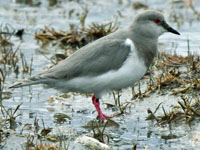
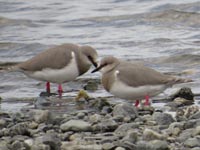
Family Pluvianidae - 1 species
Genus Pluvianus - 1 species
Plover,_Egyptian Pluvianus aegyptius Found: Africa
The Egyptian Plover has black back, crown, eye-mask, breast band; blue-gray wings; white supercilium; orange underparts; long bue-gray legs. It is a wader and breeds on sand bars.
Image by: 1) Steve Eng - Philadelphia Zoo 2) Steve Garvie - The Gambia 3) Patricia van Casteren 4) J Verde - Gambia